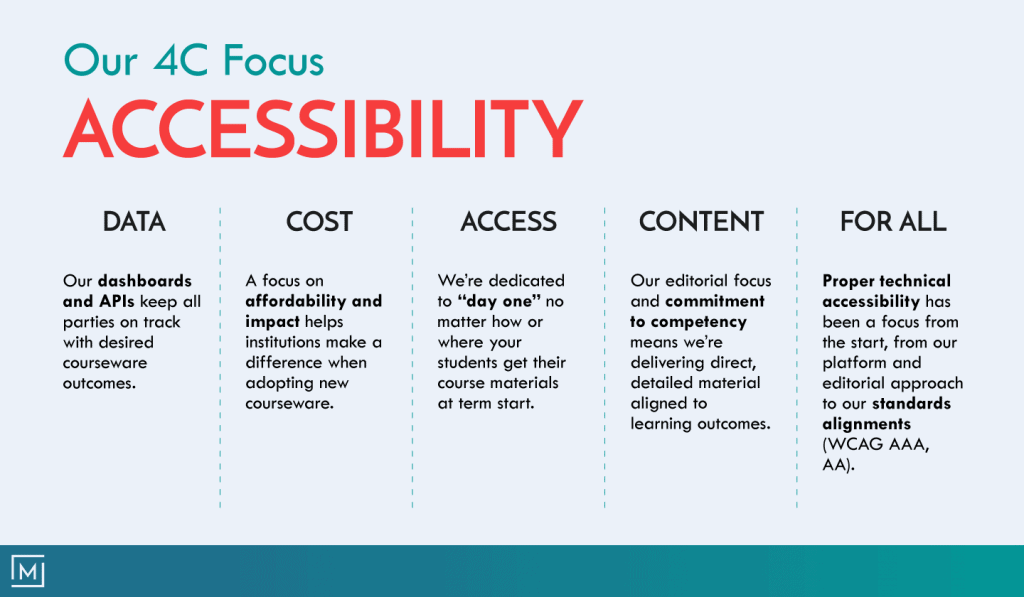Blog Post Heading
Blog Post Content
By Chris Edwards
SVP, University Partnerships, MindEdge Learning
In my last post, I ranted (a little bit) about the digital courseware accessibility problem, and pointed out that there’s a whole lot more to the story in HigherEd that we really need to think about.
In this missive, I’ll attempt to unpack that concept a little bit more. Of course, the topic of universal tech access in all manner of delivery methods is vital to the conversation about the web (and the opportunity it can bring). At the same time, we absolutely need to dig into how post-secondary students consume content.
Despite the oft-repeated assertion that digital learning will “save the world,” today’s deployments are less than optimal in many cases—and they’re not naturally primed to get better. The odds are stacked against the right kinds of innovation.
HigherEd has been talking about accessibility in education—as it relates to both access and affordability—for a long time. Here at MindEdge, we’ve been thinking about this a lot over the last 20 years. As a digital-first provider that’s focused on serving learners of all circumstances, life stages, and learning needs, we’ve had to consider a few critical items that define the content that should be used.
(I’ll stop short of calling that content mandatory, or a must. Because it’s not. As we’ve seen, read, and experienced, plenty of things are chosen in the academic context that are less than optimal. And that doesn’t seem to be naturally driving new and more holistic choices. Hence, this relatively long diatribe about what we should be doing. Which naturally blends this conversation into how we at MindEdge feel about these sorts of things).
When we think broadly about accessibility, it’s more than just the technical bits related to usability and legal liability. At MindEdge, there are four critical elements we think about in the bucket of accessibility as it relates to the material we develop: content, access, cost, and data.

CONTENT
One of the biggest factors in the push for accessibility is the consumable structure content itself. We’ve long brought the idea of outcomes to the forefront of the content we provide, module by module and topic by topic. And that’s a critical thing, because we don’t overbuild our courses to include a bunch of stuff solely for the sake of writing and maintaining it. We’re critical about delivering the content needed in the detail required to demonstrate competency in the subject. Maybe that’s just the editor in all of us, but there’s power in focusing—on what should be learned, and on what has to be consumed to figure all of that out.
ACCESS
For those studying in structured environments ruled by a calendar—a/k/a. college students—simply getting to the material is a big, big thing. There’s absolutely no learner who can afford to sacrifice up to three weeks of a six- or eight-week term waiting to get the resources to access their content. It’s the dreaded financial aid delay, or simply the lack of funds at the right time, that can sink a student’s semester. And why let 10 percent of the total cost of learning sink the other 90 percent—especially if you’ve borrowed a pretty hefty chunk of it?
So, having access to content on day one is something to which MindEdge has always been committed. Long before subscriptions and inclusive access, the MindEdge team ensured that each faculty member and institution had options for starting the course as soon as it was open to learners. From temporary access codes to bridge the gap to financial aid, to institutional enterprise pay and licensing options—our delivery and options have long conformed to the ideal needs of the learner. And that’s a commitment we’ll continue to keep.
COST
It’s important to note that it gets difficult to maintain the second aspect of this content/cost equation without the resources and infrastructure to support the first. Delivering high-quality, up-to-date, impactful edited content takes curation. And MindEdge has a dedicated team in Waltham, MA focused on supporting every part of it—from the construction of the academic elements to the development and delivery of the technology. Combined with our subject matter experts and contributors from around the US, this dedicated and talented team dedicates its time, effort, and energy to delivering a quality learning product that leads to superior outcomes for learners.
When the HigherEd marketplace (or, frankly, anyone who consumes the Internet in the decade to come) considers cost, things get tricky. A fair amount of the content available for any academic course curriculum can be found at little to no cost. But integrating that content into a stable, secure platform that allows all learners access in their academic process takes considerable effort and energy—like much of what’s happening behind the scenes to fuel the OER movement and deliver a parallel content infrastructure from scratch.
The broader consumer Internet has advertising and data (and your myriad of subscriptions to Hulu, Netflix, PrimeVideo, ESPN+, the NBC Sports Gold cycling pass, etc.) to help monetize the Internet. (It’s something you’ll experience to a dizzying degree if you search “movie streaming service” to figure out if there are other streaming services you should reference—and get bombarded with every size of pop-up ad from every kind of vendor.)
But for HigherEd content, there’s most definitely a cost that can’t be offset with ads—and shouldn’t be monetized by student data. The equation is far more complicated than tuition plus fees divided by instructor, with the textbook on the side. A provider like MindEdge has a robust infrastructure to maintain, so it can deliver content that’s fresh and relevant to the learning experience you are about to have.
So, how we feel about access and content really matters—because we’re also focused on cost. And we’re dedicated to making sure that what you’re asked to pay is a fair and affordable aspect of the broader academic equation (and journey) you are on.
DATA
The last piece of our expanded concept of accessibility is data.
Digital things generate all kinds of data—from simple exhaust data to data that’s recorded and derived from specific and purposeful interactions. HigherEd content is full of both. Using a browser will tell us a few things about your setup—things that help us make sure we’re providing support to the myriad ways you consume that content, in either a want-to or have-to way.
That’s important data; it helps us be sure we’re set up to deliver the right level and type of electronic service to support your learning.
Then there’s the more critical item: the learning data itself. The purpose-built interactions. The formative and summative assessments. The adaptive learning topics. The video, the games—all the ways we’re looking to deliver content, and foster learning and competency.
We think it’s important that all parties have clear access to the data in support of learner success. For that reason, we make sure a learner can always see exactly where they are in consuming the MindEdge content in their courseware. Looking in the dashboard is a good way to gauge individual interaction with the content, so you can evaluate what you’ve consumed and done well, as opposed to what you’ve chosen to bypass.
In almost every case, “grading” or marks within our content is independent of what a student’s particular grade or mark is in a given course. How that’s determined is up to the instructor or faculty, as always. But, data from the courseware can and should be useful to faculty and institutions alike. In flipped or blended classroom environments, discerning patterns in consumption and understanding can and should influence the nature of lecture content—to help make face-to-face time more productive.
So much time, effort, energy, and capital is invested on campus to help students succeed. Still, it’s a long and winding path to academic success for most students. To help learners make a better journey down that path, data can help formulate and align the resources that can help (or might be required). With one-on-one help an extremely finite resource, aligning needs and services is a must.
It’s very important to know how a provider like MindEdge thinks about data—from the perspective of a learner, a faculty member, an institution, and HigherEd at large.
We’re not endeavoring to build “the great black box of the future of higher education”—but simply trying to help learners on their student journey, and then beyond.
But as the HigherEd marketplace finds content providers moving into new models, we have to remember to ask these questions and keep after them. Today’s newly launched subscription service might just as well turn into that black box that doesn’t consider the student or institutional need—but endeavors to build an alternative profile that’s more linked to their commercial good.
That’s a bad outcome for the college pathway at large.
CONCLUSION
This is a critical time in the world of higher education content. What happens in the next five years is really going to set the agenda for the next 50. How we choose to deliver content, the delivery systems we build, the ways we bring this content to bear in the college context, and how we prepare students for their learning beyond—all are elements to be considered and reviewed.
Maybe the most important point: it matters less what we say on digital channels (and in posts like this one, frankly), than what we do to bring accessibility (and all of its component parts) to the forefront of all our efforts.
Chris Edwards, MindEdge’s senior vice president for University Partnerships, writes an occasional column for the MindEdge Learning blog.
Copyright © 2020 MindEdge, Inc.
